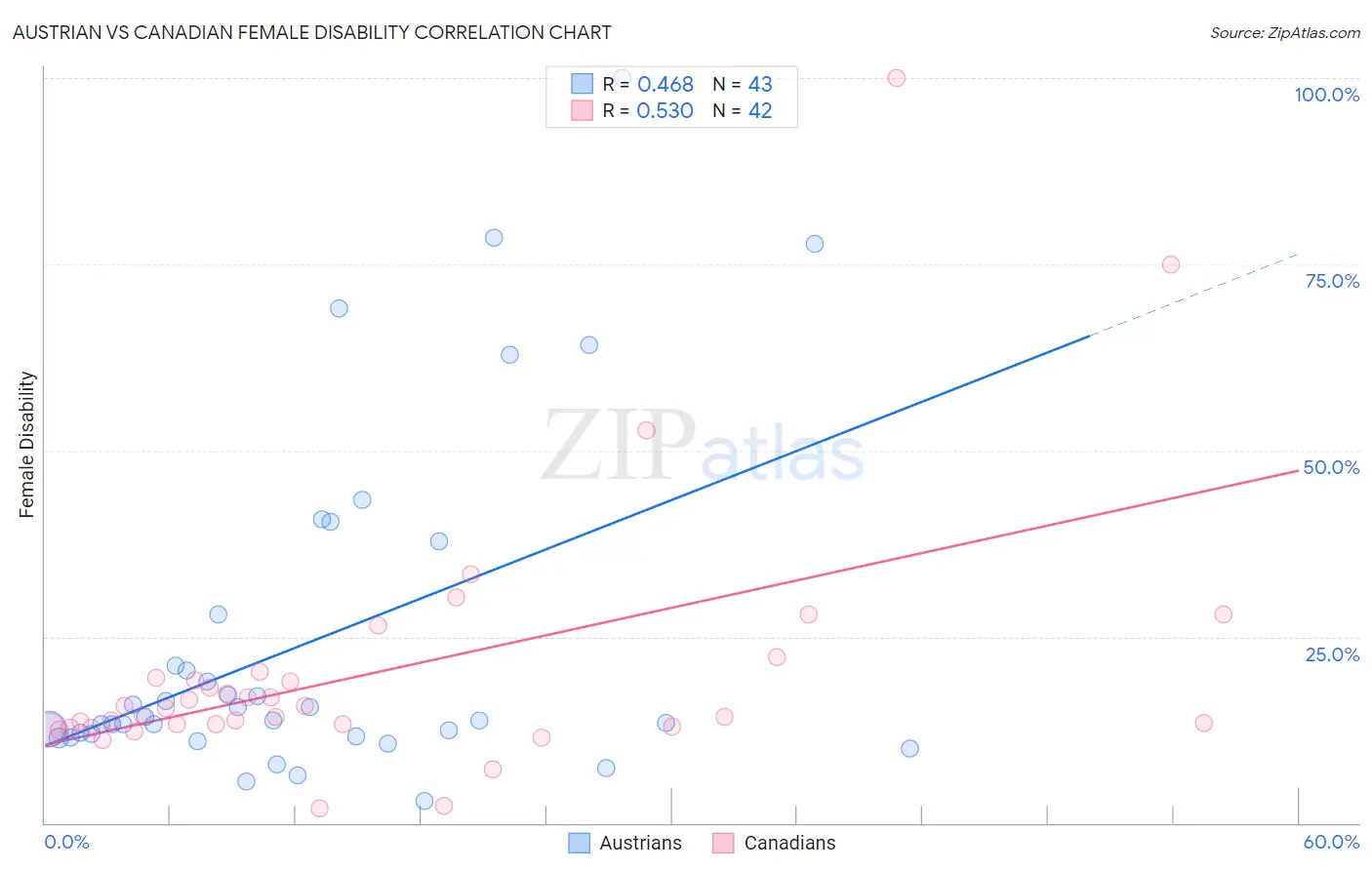Austrian vs Canadian Female Disability
COMPARE
Austrian
Canadian
Female Disability
Female Disability Comparison
Austrians
Canadians
12.3%
FEMALE DISABILITY
33.3/ 100
METRIC RATING
186th/ 347
METRIC RANK
12.6%
FEMALE DISABILITY
2.6/ 100
METRIC RATING
242nd/ 347
METRIC RANK
Austrian vs Canadian Female Disability Correlation Chart
The statistical analysis conducted on geographies consisting of 452,021,932 people shows a moderate positive correlation between the proportion of Austrians and percentage of females with a disability in the United States with a correlation coefficient (R) of 0.468 and weighted average of 12.3%. Similarly, the statistical analysis conducted on geographies consisting of 437,475,870 people shows a substantial positive correlation between the proportion of Canadians and percentage of females with a disability in the United States with a correlation coefficient (R) of 0.530 and weighted average of 12.6%, a difference of 2.8%.

Female Disability Correlation Summary
| Measurement | Austrian | Canadian |
| Minimum | 2.9% | 2.0% |
| Maximum | 100.0% | 100.0% |
| Range | 97.1% | 98.0% |
| Mean | 24.5% | 20.3% |
| Median | 13.7% | 14.9% |
| Interquartile 25% (IQ1) | 11.6% | 12.9% |
| Interquartile 75% (IQ3) | 28.0% | 19.4% |
| Interquartile Range (IQR) | 16.3% | 6.5% |
| Standard Deviation (Sample) | 23.1% | 17.6% |
| Standard Deviation (Population) | 22.8% | 17.4% |
Similar Demographics by Female Disability
Demographics Similar to Austrians by Female Disability
In terms of female disability, the demographic groups most similar to Austrians are Serbian (12.3%, a difference of 0.010%), Immigrants from Uzbekistan (12.3%, a difference of 0.020%), Immigrants from North America (12.3%, a difference of 0.020%), Immigrants from Albania (12.3%, a difference of 0.080%), and Immigrants from Honduras (12.3%, a difference of 0.090%).
| Demographics | Rating | Rank | Female Disability |
| Immigrants | Fiji | 38.2 /100 | #179 | Fair 12.3% |
| Albanians | 37.9 /100 | #180 | Fair 12.3% |
| Immigrants | Canada | 37.2 /100 | #181 | Fair 12.3% |
| Norwegians | 36.9 /100 | #182 | Fair 12.3% |
| Cubans | 36.5 /100 | #183 | Fair 12.3% |
| Iraqis | 36.0 /100 | #184 | Fair 12.3% |
| Immigrants | Uzbekistan | 33.9 /100 | #185 | Fair 12.3% |
| Austrians | 33.3 /100 | #186 | Fair 12.3% |
| Serbians | 33.1 /100 | #187 | Fair 12.3% |
| Immigrants | North America | 32.8 /100 | #188 | Fair 12.3% |
| Immigrants | Albania | 31.6 /100 | #189 | Fair 12.3% |
| Immigrants | Honduras | 31.3 /100 | #190 | Fair 12.3% |
| Armenians | 29.7 /100 | #191 | Fair 12.3% |
| Immigrants | Western Africa | 29.2 /100 | #192 | Fair 12.3% |
| Northern Europeans | 27.5 /100 | #193 | Fair 12.3% |
Demographics Similar to Canadians by Female Disability
In terms of female disability, the demographic groups most similar to Canadians are Immigrants from Senegal (12.6%, a difference of 0.010%), Alsatian (12.6%, a difference of 0.020%), Japanese (12.6%, a difference of 0.050%), Immigrants from Jamaica (12.6%, a difference of 0.16%), and Spanish American Indian (12.6%, a difference of 0.18%).
| Demographics | Rating | Rank | Female Disability |
| Malaysians | 5.0 /100 | #235 | Tragic 12.5% |
| Immigrants | West Indies | 4.4 /100 | #236 | Tragic 12.6% |
| Slavs | 3.8 /100 | #237 | Tragic 12.6% |
| Yugoslavians | 3.7 /100 | #238 | Tragic 12.6% |
| Barbadians | 3.6 /100 | #239 | Tragic 12.6% |
| German Russians | 3.2 /100 | #240 | Tragic 12.6% |
| Japanese | 2.7 /100 | #241 | Tragic 12.6% |
| Canadians | 2.6 /100 | #242 | Tragic 12.6% |
| Immigrants | Senegal | 2.5 /100 | #243 | Tragic 12.6% |
| Alsatians | 2.5 /100 | #244 | Tragic 12.6% |
| Immigrants | Jamaica | 2.2 /100 | #245 | Tragic 12.6% |
| Spanish American Indians | 2.1 /100 | #246 | Tragic 12.6% |
| Menominee | 2.1 /100 | #247 | Tragic 12.6% |
| Carpatho Rusyns | 2.0 /100 | #248 | Tragic 12.6% |
| Immigrants | Congo | 1.8 /100 | #249 | Tragic 12.7% |